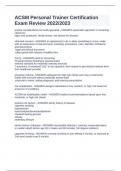ACSM Personal Trainer Certification
Exam Review 2022/2023
pretest considerations for healh appraisal - ANSWER-systematic approach in screening
clients for:
signs and symptoms, family history, risk factors for disease
informed consent - ANSWER-an agreement to do or allow something to occur, made
with an awareness of relevant facts, including: procedures, risks, benefits, limitations,
and discomforts
-legal and ethical document
-often paired with release of liability form
Par-Q - ANSWER-used for screening
Physical Activity Readiness Questionnaire
minimal standard for moderate intensity exercise
7 questions; if answered "yes" to any question, then require to get medical release form
from healthcare provider
physician referral - ANSWER-safeguard for high risk clients who may compromise
health with exercise without medically trained staff
-physician's name, stating diagnosis, and exercise perscription
risk stratification - ANSWER-assigns individuals to low, medium, or high risk based on
presence of conditions
ACSM risk stratification matrix - ANSWER-makes recommendations based upon low,
moderate, or high risk clients
positive risk factors - ANSWER-family history of disease
cigarette smoking
hypertension
hyercholesterolemia/dyslipidemia
impaired fasting glucose
obesity
sedentary lifestyle
family history of disease - ANSWER-myocardial infarction, coronary revascularization,
or sudden death before age 55 in males and 65 females (1st degree relatives)
cigarette smoking - ANSWER-currently smoking or quit withing 6 months, or exposed to
2nd hand smoke over 6 months
,hypertension - ANSWER-clients currently taking antihypertensive medication and/or
confirmed (2 separate occasions) 140/90 BP or higher
hypercholesterolemia/dyslipdemia - ANSWER-clients currently taking lipid lowering
medication and/or those with total serum cholesterol >200 mg/dL, or high density
lipoprotein cholesterols of 0.35 mg/dL
impaired fasting glucose - ANSWER-fasting blood glucose > or equal to 110 mg/dL (2
separate measurements)
obesity - ANSWER-BMI > or equal mg/m^2 or waist girth exceeding approximately 39.4
inches
sedentary lifestyle - ANSWER-those not meeting recommended amount of physical
activity (at least 30 minutes of physical activity at a moderate intensity 40-60%, at least
3 days a week for at least 3 months)
negative risk factors - ANSWER-high serum HDL cholesterol: >60 mg/dL
emerging risk factors - ANSWER-inflammatory markers: reactive C protein (CRP) and
fibrinogen
low risk - ANSWER-men <45, women <55, asymptomatic, with 1 or less risk factors
A) current medical examination and exercise testing prior participation- not necessary
for moderate or vigorous exercise
B) physician supervision of exercise tests- not necessary for submax or maximal tests
moderate risk - ANSWER-men >45, women >55, or those who meet the threshold for 2
or more risk factors
A) current medical examination and exercise testing prior participation- not necessary
for moderate but recommended for vigorous exercise
B) physician supervision of exercise tests- not necessary for submax but recommended
for maximal tests
high risk - ANSWER-1 or more signs and symptoms listed or a known cardiovascular,
pulmonary, or metabolic disease
A) current medical examination and exercise testing prior participation- recommended
for moderate or vigorous exercise
B) physician supervision of exercise tests- recommended for submax or maximal tests
exercise testing steps - ANSWER-M.R.I.P.L.
medical history
risk factor assessment
interpreting the data (cardio endurance, muscle strength/endurance, flexibility, body
comp)
prescribing exercise program
,lifestyle counseling
stress test - ANSWER-usually only recommended by physician if the client has
symptoms of coronary artery disease, or significant risk factors for CAD
do NOT do vigorous exercise with: - ANSWER-clients with diagnosed or present cardio
diseases, congenital abnormalities, and/or hereditary abnormalities:
hypertrophic cardiomyopathy
coronary arter abnormalities
aortic stenossi
signs/symptoms of cardiovascular and pulmonary disease - ANSWER--pain, discomfort,
distress in areas that may be due to ischemia (chest, neck, jaw, arms, etc.)
-shortness of breath at rest or mild exertion
-dizziness or syncope
-edema, especially ankle
-tachycardia, or other arrhythmic occurrences (known heart murmur)
-orthopnea or paroxysmal dyspnea
-intermittent claudication
-unusual fatigue or shortness of breath with ADLs
ischemia - ANSWER-an inadequate blood supply to an organ or part of the body,
especially the heart muscles.
-can result in heart attack, can by silent
intermediate condition of CAD
edema - ANSWER-puffy swelling of tissue from the accumulation of fluid
-common in arms, hands, legs, ankles, and feet, face, abdomen
*symptoms:* swelling of tissue directly under skin, stretched or shiny skin, skin that pits
after being pressed, increased abdominal size
-remove salt from clients diet may help with swelling
-can be sign of underlying disease (heart failure, kidney disease, cirrhosis of liver etc.)
orthopnea - ANSWER-ability to breathe only in an upright position
-difficulty breathing in supine position
-usually indicative of left ventricular dysfunction
paroxysmal dyspnea - ANSWER-sudden, recurring episode of difficult breathing
-asthma
angina - ANSWER-heart pain
-insufficient supply off blood
*symptoms:* chest pain/discomfort, pain in neck shoulder back arms or jaw, nausea,
fatigue, sweating, shortness of breath, anxiety, dizziness
stable angina - ANSWER-most common type
, occurring with exertion and going away with rest
can be triggered by mental or emotional stress
could feel like indigestion and spread to arms, back, or other areas
unstable angina - ANSWER-*medical emergency*
occurs even at rest and usually more severe and longer lasting (as long as 30 minutes)
-may signal heart attack!!!
arrhythmias - ANSWER-abnormal heart rhythm:
-tachycardia
-bradycardia
-atrial fibrillation
-ventricular ectopic beats (VEB
tachycardia - ANSWER-very fast heart rate
sinus: >100 bpm
atrial: >100 bpm with narrow QRS complex, w/ P waves originating not from sinus node
ventricular: potentially life threateing, >100 bpm, with at least 3 irregular heartbeats in a
row (ventricular fibrillation, asystole, or death)
bradycardia - ANSWER-unusually slow heart rate (less than 60 bpm)
atrial fibrillation (A-fib) - ANSWER-irregular heart rhythm
-continuous rapid firing of atrial foci
-no P waves
-does not completely depolariaze
-series or erratic tiny spikes
ventricular ectopic beats (VEB) - ANSWER-heartbeat arising from an abnormal focus.
Called premature beats (before next schedule heart beat) or escape beats (later than
next scheduled heart beat)
dyspnea - ANSWER-shortness of breath (SOB). difficult or uncomfortable breathing
experienced subjectively. can occur at rest or be cause by exertion
exertion cause dyspnea - ANSWER-suggests presence of cariopulmonary disorders
(especially left ventrifular dysfunction or chronic obstructive pulmonary disease)
-tachypnea
-hyperventilation
-hyperpnea
tachypnea - ANSWER-increase in respiratory rate above normal




